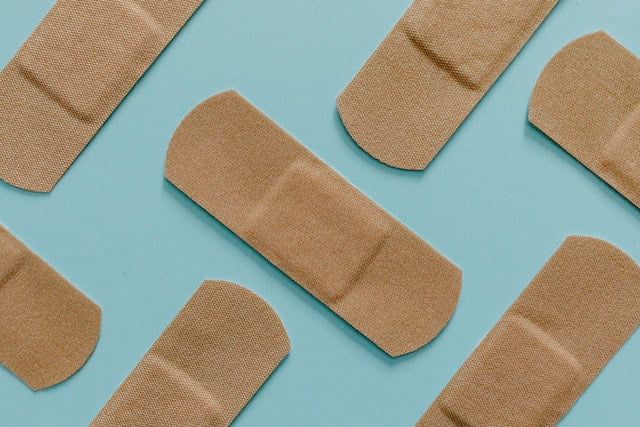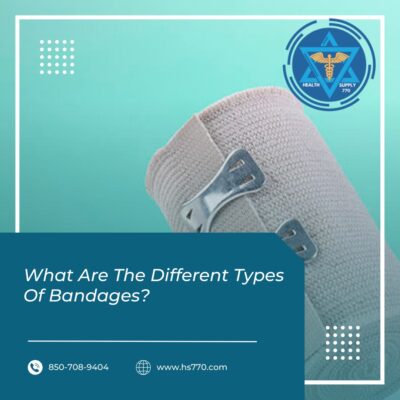Bandages have been used for a long time in the world for covering and treating wounds. The ancient Greeks used bandages and there is proof that they used bandages for different treatments. An ancient painting dating back to 5000-2500 B.C. shows a person in a bandage. Bandages are materials that are used to support other medical devices including dressing or splints. The dressing is placed directly on a wound and bandages are helpful in holding the dressing in place. These bandages are also used to provide support to or to restrict the movement of some body parts.
In our daily life, we often get hurt. These minor cuts are extremely painful, especially if you don’t treat them properly as they get hurt again and again and the pain increases. Apart from these minor cuts, sometimes we get hurt because of some accidents that may require proper treatment. No matter the size of the wound, bandages are used all over the world to treat wounds and injuries. These bandages come in all shapes and sizes. There are also different types of bandages that are used for different wounds. Today in this article we are going to discuss the different types of bandages and their uses.
However common people use the terms dressing and bandage interchangeably, these are not the same. To understand the different types of bandages first you need to know what a bandage is and how it differs from a dressing.
Difference between a dressing and a bandage
A dressing is a primary layer that comes in contact with the wound. The purpose of using a dressing is to protect the wound from further damage and speed up the healing process. However, the bandages are used for different purposes.

Difference between a dressing and a bandage
Bandages are commonly used:
- To cover the wounds
- To keep dressings in place
- To apply pressure to control bleeding
- To support a medical device for example a splint
- To restrict a part of the body
Types of bandages
Now that we have made clear the main difference between a dressing and a bandage, we can discuss the several types of bandages used in the treatment of wounds. There are different types of bandages that are used for different purposes.
Some main types of bandages include:
Gauze bandage
Gauze bandages are the most common type of bandages for wounds. These bandages come in several sizes for different wounds. A gauze bandage is made of a material with a highly absorbent barrier that prevents adhering to wounds. This absorbent material helps to absorb blood or other secretions of the wound or injury. This also helps to keep the wound clean. Gauze bandages are used specifically to hold the dressing in place. This bandage allows the air to pass through the bandage which helps the wound in healing. These bandages are often affordable and can be used for the effective treatment of wounds.
Adhesive bandage
Adhesive bandages are also known as sticking plasters, medical plasters, or simply plasters. The function of these bandages is to protect the wound from friction, damage, bacteria, and dirt. By protecting the wound from these problems, bandages help to improve the body’s healing process. It also speeds up the natural healing process of the body by holding two cut ends of skin together.
These adhesive bandages are made of fabric, plastic, or latex strip. These bandages are often used to treat wounds and injuries however some people may have an allergic reaction to the materials used in these bandages. These people should use adhesive-free bandages to avoid any allergic reaction.

Adhesive bandage
Liquid bandage
Liquid bandages help treat small wounds. These bandages are a topical treatment that helps to form a protective polymeric layer. It helps to lock moisture in and keep germs out of the wound. A liquid bandage is normally a polymer that is dissolved in a solvent and sometimes an antiseptic is also added. They help to protect the wound by forming a thin film of polymer. These are now used extensively for minor cuts and scrapes. Apart from these, these liquid bandages are now being used in surgical and veterinary offices. These are also used in the field of combat where these bandages are used to stop the flow of blood from a wound until proper medical treatment can be given.
Compression or elastic bandage
A compression or elastic bandage is used to create localized pressure. It is a stretchable bandage that is commonly used for muscle sprains and strains and restricts swelling at the site of injury. A compression or elastic bandage can refer to several bandages with different applications. These bandages are broadly classified as short-stretch and long-stretch bandages. These types are defined below.
Short stretch compression bandages
Short-stretch compression bandages are also known as low-elasticity bandages. These short-stretch compression bandages are used for their ability to provide high working pressure which helps in lymphatic drainage as well as venous flow. These bandages are made of cotton fibers that are interwoven which means that their original length can be extended by 60 percent at the time of using it. These are considered comfortable and safe for long-term treatments and are often used to treat swelling. These bandages provide high resistance against muscle contraction and external movements.
Uses of short stretch compression bandages
These bandages are used for:
- Lymphedema refers to the swelling caused by the buildup of lymph fluid in the body.
- Edema (e.g. from a poisonous bite) refers to the medical condition when the fluids get trapped in the body’s tissues. These trapped fluids cause swelling.
- Venous leg ulcers mean the pressure of the veins increase. If this high pressure continues, it can result in damage to the blood vessels in the skin and make it weak.
- Short-stretch compression bandages can be beneficial in reducing swelling caused by the buildup of body fluids and thus are helpful in treating the above conditions.
Long-stretch compression bandages
Long stretch compression bandages are also known as elastic bandages because they contain an elastic yarn that allows it to stretch more than 100 percent of its original length. These are often used to support muscles, ligaments, and tendons. These are easy to apply however these should be removed if the patient is in a resting position or asleep because their resting pressure is very high.
Uses of long stretch compression bandages
Long-stretch bandages can be used to:
- Support strains and sprains
- Provide mild compression
- Hold dressings and splints in place
Triangular bandage
A triangular bandage is also known as a cravat bandage. These bandages use safety pins to secure their place and are in the form of a right-angled triangle. This bandage can be made easily by using some fabric. The use of this bandage was made popular by the boy scouts who used their neckerchief, a part of their uniform, as a triangular bandage in their first aid lessons. Triangular bandages are very helpful for making a sling to support, elevate, or immobilize limbs. These are used after operations to protect a limb. Triangular bandages are also used in the case of a broken bone or a strain. These bandages can also help to control bleeding.
Tube bandage
Tube bandages are helpful for holding dressings onto the limbs. These are also used to give support to strains and sprains to help stop bleeding. Tube bandages are woven in a continuous circle and are applied with the help of an applicator. Tubular bandages are used to hold dressings on fingers and toes however for placing these bandages on the joints you will need an elasticated one.
Kirigami bandage
The latest addition to the types of bandages is Kirigami bandages which were invented in 2016. These bandages were inspired by the art of Kirigami. These bandages are made using 3D printing molds and use parallel slits to better fit the body parts that bend such as elbows and knees.
Conclusion
Bandages have always been an essential part of the treatment of wounds. They can be used for different treatments and are also available in a variety of shapes and sizes. These bandages are not only used by medical doctors and nurses. Every person should have a basic knowledge of these bandages and their functions as they can be really helpful to alleviate pain and stop bleeding. Bandages should also be available in homes to avoid any complications and provide relief. These bandages can help treat the wound and can also help stop the bleeding till proper medical treatment is given to treat the wound. Different types of bandages are made of different materials and have different properties which make them suitable for different problems. However, gaining a clear understanding of several types of bandages and dressings used in the medical field can help you treat wounds better and shorten the healing time of the wound.








